Operations Management Assignment: SettingUp Processing Plan &Warehouse in African Continent
Question
Task: Operations Management Assignment Task: Start Coffee is the bestselling brand of coffee in the Middle East. With the head office in Doha, the company sources coffee from South America, Africa and Asia. The raw coffee is imported to Qatar and processed and packed in the factory in Doha to be sold in the markets in Kuwait, Saud Arabia, Bahrain, Oman and the UAE.
You have been selected as the Project Manager to lead a team in setting up a processing plant & warehouse in the African Continent to help stream line its supply chain. This new plant will help to accumulate the coffee from various plantation and small holders across the continent for processing, packaging, consolidate and export directly to the markets mentioned above.
Your report should be guided and cover the below criteria with justifications and presented to the Managing Director of Qatar Coffee House WLL
1. Importance of its location and the country you have selected
2. Warehouse models and your best selection and its operations 3. Continuous improvement methods for the factory
4. Technology that will help for visibility and connectivity
The report should contains words not less than 4500 words.
Answer
Introduction
Project management in manufacturing and production businesses is dependent on a range of factors. Location is one of the key elements of this operations management assignment that relate to the proper functioning of a plant. Moreover, selection of appropriate warehouse models is another important aspect in manufacturing projects. Productions of food materials require processes of continuous improvement along with advanced technologies (Fadhil et al, 2017, p. 669). The present study is based on the new project of Start Coffee, which is a bestselling coffee brand in the Middle East. The organization is developing a warehouse and processing plant in African continent so that it can establish a streamlined supply chain network. The present report analyses the importance of the selected location for plant and warehouse through location models and evaluates different warehouse models along with the description of the operations of the company, Start Coffee. The methods for continuous improvement have been highlighted and the technologies that can assist in connectivity and visibility are also explained in the study.
Importance of the location and selected country
Location models and analysis factors influencing the selection of the location and country
As explained by Hamdan-Livramento et al., (2018, p.2018) the selection of a proper location is essential for many reasons. It has been identified that the location of a plant can determine the organizational performance. In the majority of the businesses the plant location is decided on the basis of the size as well as the nature of the organizations and the product that the company is aiming to manufacture. In a recent research Daskin and Maass, (2019, p. 382) have demonstrated that selection of location is indispensable as it can partially determine the capital as well as the operating cost of the business. Moreover, plant location can also indicate the overall nature of investment needed for any project. It is also important to select a specific location for the manufacturing plants to ensure the availability of basic facilities such as electricity, cheap labours, fuel, transportation and water. For Start Coffee, choosing the African city of Lagos, which is also the Nigerian Capital, seemed to perfect for setting up a manufacturing plant and warehouse, since it is near to the port and cheap labour as well as electricity is readily available, at a cheap rate.In the view of Karatas et al., (2016, p.172), a new allocation of capacity to respective market areas is also implied by each prospective location. On the other hand, in the choice of the location for manufacturing plants, the role of the local government is also significant.
According to Fadhil et al, (2017, p. 673), Factor rating model is one of the authentic models for identifying ideal location for manufacturing plants. The factor rating method for choosing location involves a series of steps. The first step is the identification of the important location factors. The second step of this model involves rating each of the factors based ontheir relative significance to the project. The third step of the model is to assign each location based on the merits of the locations concerning each factor. In the next stage of the model, calculation of the ratings for the chosen locations is done by multiplying factors that were assigned to every location. In the last stage, the sum product is calculated for each factor so that the best location based on factors can be identified. In the present case of the Start Coffee, the Factor Rating Model for location contributed towards choosing Lagos for setting up the manufacturing plant and warehouse. All necessary aspects like costs involved, availability of cheap labour, different forms of transportation and similar others are taken into consideration by this model.
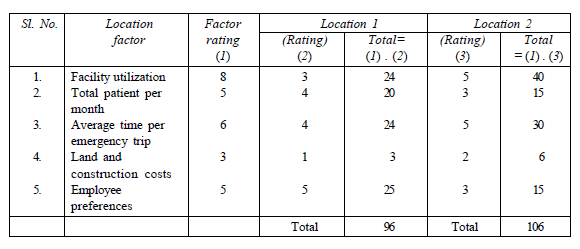
Fig 1: Example of utilization of Factor Rating Model, for identification of suitable location for setting up the outlet
(Source: theintactone.com, 2019)
The factors that generally affect on the choice of the location for plant and warehouse are the supply of raw materials, nearness to the market, transportation facilities, supply of labour, power supply, and supply and capital (Klausnitzer and Lasch, 2019, p.248). However, there are some other factors that can impact on the choice of location for the manufacturing plant of Start Coffee such as the government policies, availability of safety and security facilities, natural factors like weather, and climate, which were found to be compatible at Lagos and hence, it was chosen.
Critical evaluation of the facilities, planning process along with the layouts of optimum design
As stated by Zhu et al., (2018, p.442), facility planning is concerned with the layout, design and the accommodation for activities, machines, equipment and people of a particular system or organization within a spatial physical environment. On the other hand, Friedrich et al., (2018, p.845) has explained that facility layout design can determine the way in which arrangements, locations and distribution of different elements, equipment, machines and support services in a manufacturing facility can be done. With facility planning, the overall production time can be minimized and the arrangement and operational flexibility can be enhanced. In the case of the plant and warehouse of Start Coffee in a specific location within the African Continent, it is important to put a focus on the facility planning process so that the overall flexibility of the production process can be enhanced.
In the context of the facility planning process, Potadar and Kadam, (2019, p.877) has stated that there are different steps in the strategic facility planning process that are the set up of the planning environment, forecasting, evaluation of the scenarios and space plans, and implementation along with follow up. In subsequent research, he has explained that the different steps within the facility planning process are carried out for conducting a study, developing a budget, organizing a committee for planning and setting realistic goals. Moreover, it is also emphasized that facility planning should incorporate appropriate study of the financial marketplace and selection of appropriate people in the project. Therefore, on the basis of the overall idea of the facility planning process, Start Coffee is required to concentrate on studying the environment of the location evaluating the space scenarios and plans, planning, forecasting, budgeting, and recruiting for developing an appropriate facility plan.
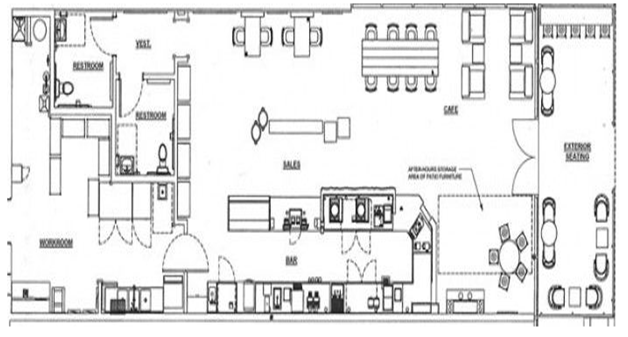
Fig 2: Facility Planning Process for space and layout of the outlet
(Source: www.foodtruckempire.com, 2019)
In a recent research Klausnitzer and Lasch, (2019, p.239), has stated that identification of optimum layout configuration is very difficult for some of the manufacturing organizations. In relation to the manufacturing industry, has mentioned the presence of three major types of layout designs that are the process layout, product layout and group layout. The group layout is divided into three major aspects that are flow line, cell and center. According to Rosenkranz et al., (2017, p.101) these layouts can be differentiated based on the characteristics of the system like product variety and production volume. According to Azgomi and Sohrabi, (2018, p.131), the product layout of design I linked with the low product variety and high product volume whereas the process layout of design is associated with high product variety and a low production volume. In the case of Start Coffee, wherein there is requirement of a low product variety but greater production volume the product layout can be explained as the optimum layout design.
Application of quantitative approaches to the location along with layout modeling
There are different quantitative approaches to compare and select appropriate locations for plants and warehouses in the manufacturing industries. Pokrovskaya (2018, p. 02014) have illustrated the dimensional analysis technique as an effective approach to location selection. The Dimensional analysis technique is a valid technique to compare two competitive locations and identify the most suitable location. In this specific technique, the cost ratios or the relative merits of the two locations in relation to the cost factors are calculated. Additionally, a proper weightage is provided to each ratio and their product is also calculated. The application of this technique is beneficial for Start Coffee as it can compare both tangible and intangible factors and can provide a quantitative value that assists in making decisions.
According to Saravana Kumar and Tholkappia Arasu (2017, p.398), the Analytic Hierarchy Process (AHP) is a quantitative methodology to model unstructured issues in the selection of a facility layout. It is an effective tool, which can help in selecting the most suitable one from a set of alternative layouts. The approach utilizes different layout design algorithms for generating candidate layout, which is then used as an input in the AHP for considering multiple performance measures. Therefore, Start Coffee can select the AHP method to select a particular layout design.
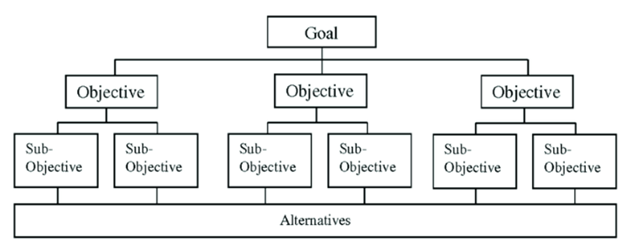
Fig 3: Depiction of the Analytic Hierarchy process
(Source: Myeong and Jung, 2019)
Selection of warehouse models along with its operation
Concepts and theories of warehousing
The concept of warehousing is the activity to stock up products that would be delivered to the customers or would be distributed in the future. According to Bimonte et al., (2017, p.915) a warehouse relates to a commercial building which is utilized for the purpose of storing products and in warehousing scientific methods can be used for making the availability of the goods in the warehouse easier. According to Moussa et al., (2019, p.135)Classical inventory management and production planning models are very effective in order to enhance the performance of warehouses in the manufacturing businesses. The models determine production and ordering policies for a single product. A contradictory view has been presented by Yuan, (2019, p.331) stating that in comparison to classical models, the inventory models of warehousing is more effective as those can effectively manage multiple products with a constraint on the total space of storage.
Inventory replenishment model is another important model in warehousing that is able to assist the manufacturing businesses to determine and control the frequency of replenishment, establishing best practices for inventory slotting and tracking the flow of goods. In this context, Nascimento et al., (2020, 139) stated that Inventory replenishment model is also effective for calculating the order quantities and identifying the optimum level that is important to be maintained for inventory to ensure the maximum efficiency in the supply chain. Therefore, Start Coffee can follow the Inventory Replenishment Model based on its product wide supply chain network.
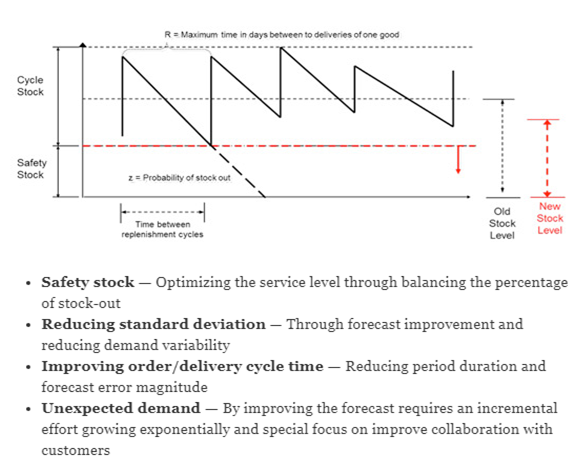
Fig 4: Inventory Replenishment Model
(Source: www.spendmatters.com, 2015)
Abuabara et al., (2019, p.7277) in a recent study, has linked the theory of Constraints to the concepts of warehousing. Theory of Constraints relates to a management philosophy that relates to the improvements of work in organizations. In the context of warehousing the theory is employed to solve the issues in the management of logistics and improvement of the production technology that are highly associated with the warehousing functions. Therefore, the understanding of the theory is important in the case of Start Coffee for improving the performance of the warehousing facilities and enhancing the performance of the organization.
Common problems related to warehousing along with the aspects of logistics within the organization
Coffee producing organizations face a number of issues concerning warehousing activities as well as the aspects of logistics. Adewole and Struthers, (2019, p.11) has listed a number of problems that are generally faced in warehousing functions in such organizations. Poor facility layout is one of the common problems identified in the coffee manufacturing companies. Rosenkranz et al., (2017, p.114) stated that the efficient usage of space is one of the critical factors for success in warehousing in the coffee industry. Inadequate space for storage and the inefficient usage of storage can cause difficulties for the employees to perform in their day-to-day warehousing functions. One major problem that the concerned organization Start Coffee can face concerning the warehousing activities is the seasonality in demand. It is evident that the demand for coffee is highly increased in specific seasons such as in the winter. Therefore, the warehouse space can become insufficient for storage of products in those specific seasons. So, it is important to consider the seasonality in demand while developing the design of warehouses. Another major problem that is likely to develop in the case of Start Coffee is the inaccurate inventory. According to Saravana Kumar and Tholkappia Arasu (2017, p.406), efficiency and accuracy to handle inventory in warehouses is changed from time to time, due to inaccurate inventory maintenance of the stock levels can be disrupted causing severe loss to the company.
Apart from the problems in Warehousing, the company Start Coffee can also face problems regarding logistics. As explained by Rosenberg et al., (2018, p.209), the common problems in logistics such as the increased cost of fuel can enhance the overall operational cost for the company. On the other hand, environmental issues can also create disruptions in the logistics aspect. In the opinion of Fadhil et al., (2017, p.671) the shortage of drivers and laborers is another major issue for the company concerning logistics. For retaining the labors the Start Coffee would be required to focus on providing attractive benefits. Therefore, it is important to consider the upcoming challenges in the warehousing and logistics for the company.
Importance of logistics to stocking and warehousing
It has been identified that logistics play a crucial role in the management of the supply chains in the coffee producing organizations. Rosenberg et al., (2018, p.210) has demonstrated that logistics to stock is used for planning and coordinating the proper flow of the products in a safe, timely and effective manner. The researcher has emphasized that once the coffee is manufactured it is important to focus on export logistics, regulatory and custom agency clearances, warehousing as well as local distribution. The logistics functions are therefore important for timely delivery of the products to the customers. In relation to export of coffee from one country to another, Fadhil et al., (2017, p.669) have explained that shipping of the products internationally needs strict contingency plans along with prompt communications between the logistics partners, shipping lines, and freight companies. So, for Start Coffee that operates mainly in the Middle East and looking for developing plants and warehouses in African Continent, logistics to stocking and warehousing practices are of greater importance.
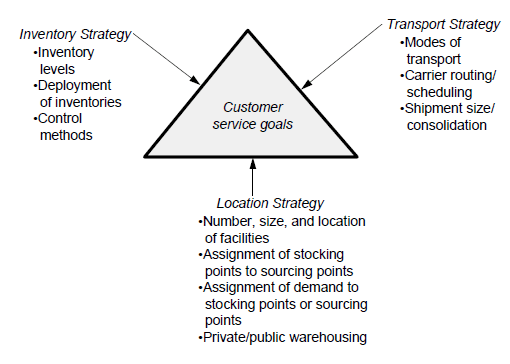
Fig 5: The Triangle of Logistics strategy
(Source: Ballou, 2017)
Methods of continuous improvement for the factory
Guiding principles of lean manufacturing
According to Visser, (2020, p. 5), lean manufacturing is mainly concerned with the methodology that generally emphasizes on minimising the waste within the systems of manufacturing whereas; simultaneously maximising the productivity. Lean manufacturing is mainly related to the number of some particular principles like continuous improvement and similar others. Thus, considering the fact of continuous improvement within the respective organisation of Start Coffee and its new processing plant along with the warehouse, lean manufacturing is known to enable the business to increase their production; improving the quality; reduction of the cost and increasing the profits through following several key principles.
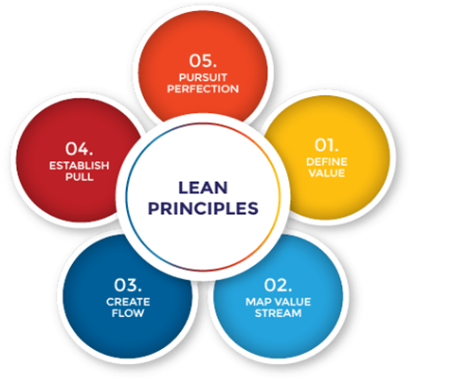
Fig 6: Principles of Lean manufacturing
(Source: The Lean Way, 2020)
These principles of lean manufacturing which needs to be followed by the concerned company are mentioned below:
Identify value:
This has been the first principle which has been the first step of the journey for becoming lean. The respective steps generally require the business to define the value of the customers along with the way their services and the products meet expectations (Tetik et al., 2019, p. 102910). For instance, through designing the products for meeting with the requirements of the customers can mitigate the wasteful steps. Designing for six sigma is yet another example, which can help in identification of value through which the concerned company can measure; define as well as analyse the wants of the customers.
Mapping the value stream:
This step generally requires the organisation for identifying the value stream of its products where the company can make use of Value Stream Mapping, which is a lean tool and can help in reducing the steps that do not add any value.
Create flow:
This is concerned with the efficient flow of products that need the items for moving through the production towards shipping beside any of the interruptions (Agrawal et al., 2019, p. 10). Thus, for the present case, every aspect needs to be emphasized such as equipment and people towards shipping and material that should be considered for ensuring the products move seamlessly with the process of production.
Establish pull:
This is considered to be a pull based system of production which is easy for creating and generally results within the larger inventories along with work in progress. Undertaking this approach requires Start Coffee to increase the output; maximising the usable workspace; eliminating overproduction as well as underproduction; reduction of inventories and elimination of errors that are caused through having too much work within progress.
Seeking perfection:
This can result in being difficult for successful application within the workplace. As stated by da Conceição et al., (2019, p. 170), seeking perfection needs the organisation to continuously improve its practices along with requiring a shift within the culture of the workplace.
Concept of cell production and its characteristics
With cell production, all the assembly lines are known to be broken down within the groups of the related activities rather than the individual ones. The cells have been arranged normally with a shape of U- or rather horseshoe-shaped. Each of the teams that are self-contained has been responsible regarding the completion of a product or rather particular process. Thus, this is mainly referred to as a teamwork, which considers the entire process based on production that is split into the smaller groups known as cells. Each of the cells are responsible for the completion of the unit for work.
Start Coffee, can adopt the method of cell production for its employees, which can help them in improving their motivation along with the morale as the employees might become bored through the repetitive work and this type of teamwork has resulted in being popular for mass production through the human system (Harrison et al., 2019, p. 9). However, there are several advantages and disadvantages of using the respective method. For instance, this can improve communication while managing the scheduling and maintenance; this considers the requirements of low stock along with minimal work within progress that eventually allows to have operation with the system of just-in-time. On the other hand, this might not allow the company to make use of the machinery as an intensive production of in-flow as well as output that can be lower than the mass production for being a result. This needs a big investment for new management as well as the process of control like stock ordering.
Concept of just-in-time manufacturing and its benefits for the organisation
Just-in-time is known to be a method of inventory management where the goods; materials as well as labours are tend to be scheduled for the arrival or rather be directly replenished while being required in the process of production. According to Featherall et al., (2019, p. 395), just-in-time manufacturing generally addresses all the respective concerns and is considered to be the target and system that can reduce the times for which a product spends while going through the production; similarly, cutting back with the response time through the suppliers. Controlling these variables has been a key for holding the cost of production along with increasing the productivity. Thus, the JIT manufacturing is referred to as a model of production where the items are generally created for meeting the demand and not created within the surplus or rather the advance based on need. Start Coffee can implement JIT manufacturing in its production system, which can be the means for elimination of the wastes.
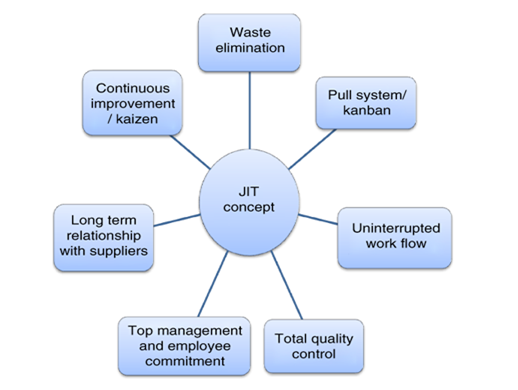
Fig 7: The concept of Just-in-Time Approach
(Source: Nunhes et al., 2019)
Within the inventory management of the concerned company, the JIT system tends to reduce wastage along with improving the efficiency as well as productivity that contributes for a smoother flow of production (Nunhes et al., 2019, p. 985). However, a shorter cycle of production is able to decrease the financial costs; labour costs and inventory costs. However, there are several disadvantages related to the implementation of this particular system of manufacturing. For instance, there is a risk for the products to be stock out where JIT manufacturing cannot help in carrying much stock. Nevertheless, this can also result in lack of control for the period that is to be dependent within the timelessness for the suppliers regarding each of the orders that are put for the risks in delaying the receipt of the customers for the goods. On the contrary, the JIT inventory has been a stratagem, which is utilised by the manufacturers for increasing the efficiency along with decreasing the waste through receiving the goods when they are required within the process of manufacturing. This is for reducing the inventory cost and most significantly, the manufacturers are needed to forecast the requirements in an accurate manner. As per the views of Waltersmann et al., (2019, p. 1142), this considers a smooth flow of production while making use of a pull method as well as maintaining the equipment and employee satisfaction.
Technology for connectivity and visibility
Role of forecasting and linear programming within the materials planning
Linear programming within forecasting is through the optimal and dynamic systems where a new model of linear programming has been formulated regarding the optimal design for dynamic systems. It is generally based on the multistage process where some of the outputs of one of the stages are known to be the inputs for the next stage. Forecasting is referred to as a significant function within a company that can help with the planning of production. An organisation should quantify with the demands for the goods for assisting with quantities and planning for the finished goods (Antonczak, 2020, p. 25). This can allow the planning department of the organisation for developing plans for purchasing labours and goods regarding the production of the labours. Hence, forecasting can allow Start Coffee for making use of the historical data through analysis of the employees like trend analysis or rather moving average for prediction of the future demand. This kind of analysis might be informed through the contracts of future sales along with market research for refining the demand of the future. The respective data can then be used for the formulation of future demand regarding several quantities. This demand for several quantities can allow the organisation for the estimation of the materials; hours of equipment and labour that is needed for building the products.
While making this analysis, Start Coffee needs to consider the function of materials planning which can help in finding about the company to be constrained through particular resources like machine output; labour and materials within some of the units that can be made by the goods. As put forward by Pundir et al., (2019, p. 0156), this is something where linear programming may be used for maximising the resources and profits along with minimising the costs. The respective analysis can provide with the planning of the organisation through the unit numbers for the product of the organisation that needs to be considered while meeting with the minimisation or rather maximisation objective of the organisation. Thus, this is concerned with the linear programming, which is a significant tool that might be leveraged through the function of materials planning.
Concepts of lead time optimisation and network optimisation
Lead-time is mainly referred to as the delay that is applicable for the purposes of inventory control. This concernssituations where the respective delay has been typically for the sum of the supply delay such as the time that is takes for a supplier in delivering the goods after an order has been placed along with reordering delay, which has been the time until the opportunity of ordering that arises again. Thus, the lead-time optimization has been the optimized management and selection of the inbound options of supply in regards with an uncertain demand as well as longer times of production, which is critical for achieving important savings of supply chain within higher turnover (Edwards et al., 2019, p. 10). On the other hand, network optimisation is considered as a set of technologies as well as techniques, which are geared for the improvement of network performance. These techniques generally seek to manage the utilisation of bandwidth along with minimising the latency and packet loss along with jitter and congestion, creatively. Based on the supply chain of the respective organisation, the network optimisation can be able to empower the company for comparing its recent state related to its supply chain for multiple scenarios. They might then develop concise goals and plans of strategy that are based on sound metrics.
Thus, adoption of lead-time optimization along with its reduction can allow the flexibility within its rapid shifts of the market; consists of the ability for outpacing the competitors through an efficient output (Raj and Ponnekanti, 2019, p. 531). On the other hand, this can also help in allowing the departments and management of Start Coffee to meet deadlines in a continuous way and much easier way. However, implementation of network optimisation can also lead the present organisation to allow a faster transfer of data involving the transfer of bulk data; reduction in the expenses of bandwidth; disaster for recovery capabilities along with improving the time of response regarding interactive applications such as software applications and databases.
Relevance of Mintab; Excel; ERP and SAP within materials planning
Businesses are required to communicate; understand and measure the performance of its processes that can enable control leading to decision-making and improvement. For all these purposes, technology plays an effective role for all the organisations including Star Coffee. As opined by Scribbins and Curran, (2020, p. 15), there are several technological tools or rather softwares that are used by the particular company such as Mintab which is mainly used for analysing the data; process based on the improvement and statistical tools. It helps the organization for spotting the trends along with solving problems. This is well suited within the material planning through the instructional applications however, is powerful enough for being used as a primary tool to analyse the data of research. On the other hand, material planning template is also used while considering the excel template that is created with the use of macros. This has been a scheduling and lower cost tool. This helps in maintaining the database. However, Mintab is considered to be better than Excel as it has been general spreadsheet software for programs. This has been great for the compilation sorting along with highlighting a larger amount of the data. On the contrary, as opposed by Dotoli et al., (2019, p. 5047), mintab is able to create a bar chart in direct manner through the raw data within the worksheet. Hence, with just some clicks, the minitab can produce results.
ERP is referred to as enterprise resource planning which can also be used in the concerned organisation as it can help in managing the process of manufacturing such as planning of production; inventory management and scheduling as well. This is also known to be the extension of the MRP system. On the other hand, SAP process is also in existence, which calculates the net requirements to consider the available stock of the warehouse along with the scheduled receipts through production and purchasing (Waltersmann et al., 2019, p. 1142). This can help in creating the proposals for procurement such as scheduled lines; planned orders; purchasing requisitions that are based on the settings of the planning run. Thus, all these softwares can help in managing the planning of production; inventory control and scheduling in a better manner.
Conclusion
To conclude, the present study evaluated the different aspects related to operations management and design within the organisation of Star Coffee. As the organisation has been found to set up a processing plan as well as a warehouse within the African Continent to reach out different regions of the world for its business, certain relevant concepts have been outlined in the above discussion. Significance of the present country and location along with models of warehouse has been considered. On the other hand, the methods related to continuous improvement and advancement of technology has also been highlighted within the present study emphasizing on different theories and issues related to these concepts.
References
Abuabara, L., Paucar-Caceres, A. and Burrowes-Cromwell, T., 2019. Consumers’ values and behaviour in the Brazilian coffee-in-capsules market: promoting circular economy. International Journal of Production Research, 57(23), pp.7269-7288.
Adewole, A. and Struthers, J.J., 2019. Trade and Economic Development in Africa: The Interaction Between Logistics and Global Value Chains. In Logistics and Global Value Chains in Africa (pp. 3-15). Palgrave Macmillan, Cham.
Agrawal, V.V., Atasu, A. and Van Wassenhove, L.N., 2019. OM Forum—New Opportunities for Operations Management Research in Sustainability. Manufacturing & Service Operations Management, 21(1), pp.1-12.
Antonczak, L., 2020. Mobile technology: A new ba of work organisation. Journal of Innovation Economics Management, (1), pp.11-37.
Azgomi, H. and Sohrabi, M.K., 2018. A game theory based framework for materialized view selection in data warehouses. Engineering Applications of Artificial Intelligence, 71, pp.125-137. Ballou, R., 2017. Business logistics: importance and some research opportunities. Gestão & Produção, 4(2), pp.117-129.
Bimonte, S., Zaamoune, M. and Beaune, P., 2017. Conceptual design and implementation of spatial data warehouses integrating regular grids of points. Operations management assignmentInternational Journal of Digital Earth, 10(9), pp.901-922.
da Conceição, C.S., Broberg, O., Paravizo, E. and Jensen, A.R., 2019. A four-step model for diagnosing knowledge transfer challenges from operations into engineering design. International Journal of Industrial Ergonomics, 69, pp.163-172.
Daskin, M.S. and Maass, K.L., 2019. Location Analysis and Network Design. In Operations, Logistics and Supply Chain Management (pp. 379-398). Springer, Cham.
Dotoli, M., Fay, A., Mikowicz, M. and Seatzu, C., 2019. An overview of current technologies and emerging trends in factory automation. International Journal of Production Research, 57(15-16), pp.5047-5067.
Edwards, L., Philip, F. and Gerrard, Y., 2019. Communicating feminist politics The double-edged sword of using social media in a feminist organisation. Feminist Media Studies, pp.1-18.
Fadhil, R., Maarif, M.S., Bantacut, T. and Hermawan, A., 2017. Alternative assessment of development in the quality management system of Gayo coffee agroindustry using non-numeric multi experts-multi criteria decision making approach. In Proceedings of Aceh Developmnent International Conference (ADIC) (pp. 668-678).
Fadhil, R., Maarif, M.S., Bantacut, T. and Hermawan, A., 2017. Alternative assessment of development in the quality management system of Gayo coffee agroindustry using non-numeric multi experts-multi criteria decision making approach. In Proceedings of Aceh Developmnent International Conference (ADIC) (pp. 668-678).
Featherall, J., Chaitoff, A., Simonetti, A., Bena, J., Kubiak, D., Rothberg, M., Roumina, K., Hurle, N., Henricks, W. and Yerian, L., 2019. Creating a Culture of Continuous Improvement in Outpatient Laboratories: Effects on Wait Times, Employee Engagement, and Efficiency. American Journal of Medical Quality, 34(4), pp.389-397. Friedrich, C., Klausnitzer, A. and Lasch, R., 2018. Integrated slicing tree approach for solving the facility layout problem with input and output locations based on contour distance. European Journal of Operational Research, 270(3), pp.837-851.
Hamdan-Livramento, I., Samper, L., Giovannuci, D., Marques, L.V. and Juma, C., 2018. A Perfect Brew: Leveraging Intangible Capital to Move up the Coffee Value Chain. Harvard Sustainability Science Program Working Paper, 1, p.2018.
Harrison, C., Wachen, J., Brown, S. and Cohen-Vogel, L., 2019. A View from Within: Lessons Learned from Partnering for Continuous Improvement. Teachers College Record, 121(9), p.n9. Karatas, M., Razi, N. and Tozan, H., 2016. A comparison of p-median and maximal coverage location models with Q-coverage requirement. Procedia Engineering, 149, pp.169-176.
Klausnitzer, A. and Lasch, R., 2019. Optimal facility layout and material handling network design. Computers & Operations Research, 103, pp.237-251.
Moussa, F.Z.B., De Guio, R., Dubois, S., Rasovska, I. and Benmoussa, R., 2019. Study of an innovative method based on complementarity between ARIZ, lean management and discrete event simulation for solving warehousing problems. Computers & Industrial Engineering, 132, pp.124-140.
Myeong, S., and Jung, Y., 2019. Structure of Analytic Hierarchy Process. Available from: https://www.researchgate.net/figure/The-Structure-of-the-analytic-hierarchy-process-AHP-process-Source-Razikin-MAM_fig4_334623244 [accessed 14 May, 2020]
Nascimento, A., Tavares, E., Alves Jr, G., Sousa, E. and Nogueira, B., 2020. Performability evaluation of transport modes for cloud-based inbound logistics: a study based on coffee industry. International Journal of Manufacturing Technology and Management, 34(2), pp.126-147.
Nunhes, T.V., Bernardo, M. and Oliveira, O.J., 2019. Guiding principles of integrated management systems: Towards unifying a starting point for researchers and practitioners. Journal of cleaner production, 210, pp.977-993.
Pokrovskaya, O., 2018. Terminalistics as the methodology of integrated assessment of transportation and warehousing systems. In MATEC Web of Conferences (Vol. 216, p. 02014). EDP Sciences. Potadar, O.V. and Kadam, G.S., 2019. Development of Facility Layout for Medium-Scale Industry Using Systematic Layout Planning. In Proceedings of International Conference on Intelligent Manufacturing and Automation (pp. 473-483). Springer, Singapore.
Pundir, A.K., Jagannath, J.D. and Ganapathy, L., 2019, January. IMPROVING SUPPLY CHAIN VISIBILITY USING IoT-INTERNET OF THINGS. In 2019 IEEE 9th Annual Computing and Communication Workshop and Conference (CCWC) (pp. 0156-0162). IEEE.
Raj, D. and Ponnekanti, S., 2019, March. Connectivity Platform to Deliver Sync as a Service for 5G Digital Enterprise. In 2019 International Conference on Wireless Communications Signal Processing and Networking (WiSPNET) (pp. 530-533). IEEE. Rosenberg, L., Swilling, M. and Vermeulen, W.J., 2018. Practices of Third Wave Coffee: A Burundian Producer's Perspective. Business Strategy and the Environment, 27(2), pp.199-214.
Rosenkranz, C., Holten, R., Räkers, M. and Behrmann, W., 2017. Supporting the design of data integration requirements during the development of data warehouses: a communication theory-based approach. European Journal of Information Systems, 26(1), pp.84-115.
Saravana Kumar, R. and Tholkappia Arasu, G., 2017. Rough set theory and fuzzy logic based warehousing of heterogeneous clinical databases. International Journal of Uncertainty, Fuzziness and Knowledge-Based Systems, 25(03), pp.385-408.
Scribbins, A. and Curran, K., 2020. Automation of Detection and Fault Management Response of Common Last-Mile Loss-Of-Connectivity Outages Within the Access Network. International Journal of Wireless Networks and Broadband Technologies (IJWNBT), 9(1), pp.1-26.
Tetik, M., Peltokorpi, A., Seppänen, O. and Holmström, J., 2019. Direct digital construction: Technology-based operations management practice for continuous improvement of construction industry performance. Automation in Construction, 107, p.102910.
The Lean Way, 2020. The Five Principles of Lean. Available at: https://theleanway.net/The-Five-Principles-of-Lean [Accessed 14 May 2020].
theintactone.com, 2019. Plant Location Methods, Factor Rating Method. Available at: https://theintactone.com/2019/06/17/pom-u2-topic-2-plant-location-methods-factor-rating-method/ [Accessed 14 May 2020].
Visser, W.F., 2020. A Blueprint for Performance-Driven Operations Management. Mining, Metallurgy & Exploration, pp.1-9.
Waltersmann, L., Kiemel, S., Amann, Y. and Sauer, A., 2019. Defining sector-specific guiding principles for initiating sustainability within companies. Procedia CIRP, 81, pp.1142-1147. www.foodtruckempire.com, 2019. How to Create an Awesome Coffee Shop Floor Plan (Any Size or Dimension). https://foodtruckempire.com/. Available at: https://foodtruckempire.com/coffee/design-layout/ [Accessed 14 May 2020]. www.spendmatters.com, 2015. Does Your Inventory Replenishment Model Fit With Company Objectives. Spend Matters. Available at: https://www.spendmatters.com/2015/10/20/does-your-inventory-replenishment-model-fit-with-company-objectives/ [Accessed 14 May 2020].
Yuan, Q., 2019. Does context matter in environmental justice patterns Evidence on warehousing location from four metro areas in California. Land use policy, 82, pp.328-338. Zhu, T., Balakrishnan, J. and Cheng, C.H., 2018. Recent advances in dynamic facility layout research. INFOR: Information Systems and Operational Research, 56(4), pp.428-456.












